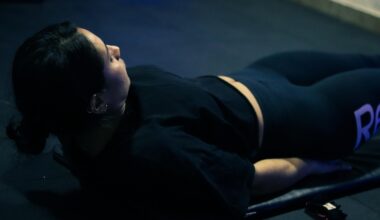The Influence of Footwear on Cycling Biomechanics and Power Transfer
Footwear plays a crucial role in cycling biomechanics and the efficiency of power transfer from the cyclist to the bike. Proper cycling shoes are particularly designed to enhance performance by improving connection and stiffness. When shoes are clipped into the pedals, the alignment of the foot significantly affects biomechanics, optimizing power transfer during pedaling. The rigidity of the sole contributes to better energy transfer through the pedal stroke, allowing cyclists to exert force more effectively. Conversely, shoes with softer soles can defer energy emission, reducing performance potential. Newly designed cycling shoes embody a balance of flexibility and stiffness to provide optimal comfort without sacrificing performance. Additionally, the material of the shoe affects the biomechanics; lightweight materials enhance performance yet must remain durable. Climatic conditions such as temperature also influence shoe selection. For instance, the thermal properties may change how materials react under pressure. Consequently, an informed selection of footwear can lead athletes to improved biomechanical efficiency. This efficiency translates to speed and endurance improvements over a long-distance ride. Overall, every design element in cycling shoes impacts a cyclist’s performance on various levels.
Affecting Factors on Cycling Performance
Cycling is not merely about pedaling; it involves complex biomechanics that are directly influenced by footwear choices and designs. One significant factor affecting performance is the fit of the cycling shoe. Shoes that fit poorly can lead to foot discomfort, inhibiting the ability to exert maximum force while cycling. Proper fitting shoes are essential for maintaining alignment, ensuring that the power generated is transferred more effectively to the pedals. Another important element is the pedal system used in conjunction with the shoe. Cycling shoes come with different cleats (e.g., SPD, Look) that impact how well the shoe connects with the pedal. Each system has unique biomechanical advantages and disadvantages. For instance, a clipless pedal system allows a more efficient power transfer by securing the foot in place, which can reduce energy loss. On the flip side, riders who use platform pedals may sacrifice efficient power transfer in exchange for ease of use. The biomechanics of human movement differ among cyclists as well, making the correct shoe and pedal pairing essential for optimal performance.
The anatomy of the cyclist’s foot significantly influences overall cycling efficiency. When shoes are properly aligned with the cyclist’s foot, the biomechanics of the pedal stroke improve dramatically. This connection enhances the production of force during the upstroke and downstroke of pedaling. Athletes should also consider the arch support of their cycling shoes; high or low arches demand different designs. Purchasing shoes with adjustable or customizable insoles can help accommodate varied foot shapes. As cyclists pedal, the distribution of pressure changes throughout the foot, necessitating a shoe that can adapt to these fluctuations. Additionally, shoes that allow for a natural foot movement can reduce fatigue and discomfort during long rides. Evaluating different brands and styles in relation to personal comfort and fit is essential. The shoe’s heel cup and toe box should provide a snug fit without excessive restriction. Furthermore, breathability and moisture-wicking properties help keep the feet dry, contributing to overall comfort. The specific balance of these elements results in a footwear choice that can directly enhance cycling performance and biomechanical efficiency.
The Role of Shoe Stiffness
Shoe stiffness is vital in cycling biomechanics, profoundly influencing performance and comfort levels. Stiffer soles enable efficient power transmission by minimizing flex during the pedal stroke. This stiffness helps translate the force from the cyclist’s legs directly into angular momentum on the bicycle’s drivetrain. Riders often choose cycling shoes with varying stiffness levels optimizing their cycling style, whether for racing or recreational purposes. More competitive cyclists generally prefer extremely stiff soles to gain a competitive edge in speed and power output. However, the trade-off for higher stiffness often leads to decreased comfort, especially over longer durations. Riders should test multiple shoe stiffness levels to determine optimum performance alignment with their cycling goals. On the other hand, some cyclists prioritize comfort over rigidity, opting for moderate to soft shoes which may enhance riding endurance. Ultimately, the chosen stiffness must align with the riding style, ensuring comfort while maximizing performance. Cycling brands constantly innovate with composite materials and design techniques to achieve this balance. Test rides and personal experience remain key factors for riders when selecting cycling shoes, reflecting the individual nuances of biomechanics.
Transitioning from traditional clip-in shoes to newer designs requires cyclists to assess how their biomechanics adapt to changes. Newer shoe technology allows for customization, accommodating various foot shapes and arch types. Adjustable bolt placements on shoe plates offer better alignment, enhancing energy transfer directly from legs to pedals. These advancements can significantly benefit riders looking to maximize their rolling efficiency and minimize fatigue during long rides. Furthermore, many brands are incorporating lightweight materials, which improve performance while maintaining structural integrity. Innovations in shoe designs are also considering factors like aerodynamic properties and heat regulation. Cyclists now have access to shoes that not only perform well but also promote better foot temperature control. As riding environments change, the adaptability of these shoes opens opportunities for enhanced performance. Additionally, the aesthetics of cycling footwear has progressed, allowing for more personal expression without sacrificing functionality. However, it remains vital for athletes to prioritize fit and comfort over style in their footwear choices. Investing time in selecting the right cycling shoe supports long-term enjoyment of the sport, vital for recreational and competitive cyclists alike.
Professional Insights on Shoe Selection
Professional coaches and seasoned cyclists agree that footwear selection is pivotal for achieving optimal cycling biomechanics and performance. The impact of proper shoe choice extends beyond power transfer; it affects posture, which can subsequently influence muscle strain during rides. A common mistake among cyclists is neglecting footwear choice during bike fitting processes. Seeking professional advice ensures an educated decision when selecting shoes for both performance and comfort. Furthermore, riding conditions such as terrain and climate significantly dictate shoe selection. Cyclists tackling rough terrains may require shoes with additional grip to provide stability while climbing or descending. For instance, off-road cyclists might prefer shoes with aggressively textured soles for enhanced traction. On the other hand, racers could favor flat soles with minimal tread to maximize aerodynamics. Furthermore, shoe weight also determines cyclists’ efficiency levels. Light shoes may enhance performance but could compromise durability in rough conditions. Ultimately, understanding the multidimensional factors of shoe selection can significantly improve cycling performance. As technology advances, cyclists can benefit from shoes that integrate cutting-edge designs to achieve optimum biomechanical advantage.
The continuing evolution of cycling footwear technology represents an exciting frontier in optimizing biomechanics. Innovations in shoe manufacturing now incorporate advanced materials that cater to specific ride types, enhancing performance and comfort. For instance, the use of carbon fiber for shoe soles is steadily increasing, as it offers an exceptional strength-to-weight ratio. This material allows for a stiffer sole without adding unnecessary weight, thus improving power transfer efficiency. Additionally, manufacturers are embracing adaptive fitting technologies, creating shoes that mold to the cyclist’s foot shape over time. This customization leads to an improved fit, thereby enhancing overall comfort. Notably, the introduction of 3D printing technology in shoe design further allows for tailor-made solutions that suit individual biomechanical requirements. As research progresses, the cycling community is likely to witness a wave of innovations aimed at refining footwear performance criteria. From energy return capabilities to pressure distribution systems, these new technologies promise to enhance the overall cycling experience. Ultimately, investing in high-quality and appropriately selected footwear can significantly influence a cyclist’s performance, reflecting the profound relationship between footwear design and cycling biomechanics.
In conclusion, cycling footwear has a deeply influential role in the biomechanics of cycling and power transfer. The insights gained through research into footwear design underscore the necessity for cyclists to prioritize the selection of appropriate shoes. Factors such as fit, stiffness, materials, and specific riding conditions dictate how effectively a cyclist can perform. Awareness of how these elements affect biomechanics equips athletes with the knowledge needed to choose shoes that complement their unique riding style. Continuous advancements in shoe technology promise to shape the future of cycling performance further. As cyclists become more informed regarding the importance of their footwear, the potential for improved performance increases dramatically. Making educated decisions based on professional inputs and personal experiences can guide cyclists toward their best choices. Never underestimate the impact of well-fitted shoes; they not only enhance biomechanical efficiency but also contribute significantly to overall cycling comfort and endurance. As the sport evolves, so too must the approaches to cyclist equipment, ensuring a performance edge through well-designed footwear. By integrating these insights, cyclists can achieve their utmost potential and enjoy an enhanced cycling experience.


